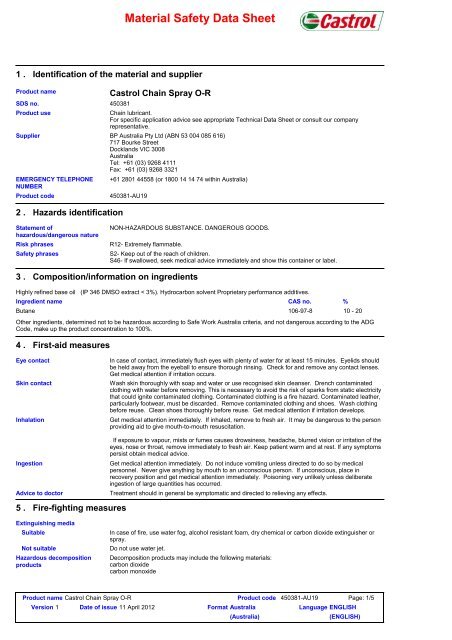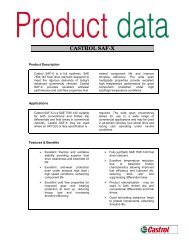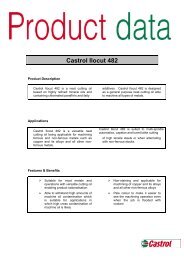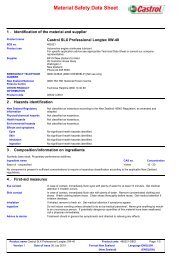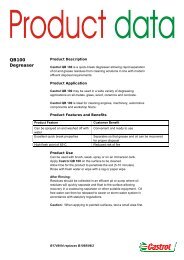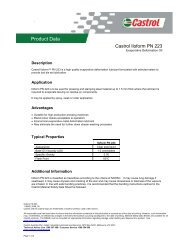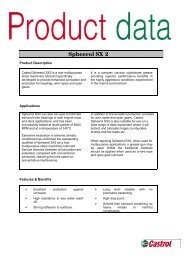Material Safety Data Sheet - industlubes.co.nz
Material Safety Data Sheet - industlubes.co.nz
Material Safety Data Sheet - industlubes.co.nz
Create successful ePaper yourself
Turn your PDF publications into a flip-book with our unique Google optimized e-Paper software.
<strong>Material</strong> <strong>Safety</strong> <strong>Data</strong> <strong>Sheet</strong><br />
1 . Identification of the material and supplier<br />
Product name<br />
SDS no.<br />
Product use<br />
Supplier<br />
EMERGENCY TELEPHONE<br />
NUMBER<br />
Product <strong>co</strong>de<br />
Castrol Chain Spray O-R<br />
450381<br />
Chain lubricant.<br />
For specific application advice see appropriate Technical <strong>Data</strong> <strong>Sheet</strong> or <strong>co</strong>nsult our <strong>co</strong>mpany<br />
representative.<br />
BP Australia Pty Ltd (ABN 53 004 085 616)<br />
717 Bourke Street<br />
Docklands VIC 3008<br />
Australia<br />
Tel: +61 (03) 9268 4111<br />
Fax: +61 (03) 9268 3321<br />
+61 2801 44558 (or 1800 14 14 74 within Australia)<br />
450381-AU19<br />
2 .<br />
Hazards identification<br />
Statement of<br />
hazardous/dangerous nature<br />
Risk phrases<br />
<strong>Safety</strong> phrases<br />
NON-HAZARDOUS SUBSTANCE. DANGEROUS GOODS.<br />
R12- Extremely flammable.<br />
S2- Keep out of the reach of children.<br />
S46- If swallowed, seek medical advice immediately and show this <strong>co</strong>ntainer or label.<br />
3 .<br />
Composition/information on ingredients<br />
Highly refined base oil (IP 346 DMSO extract < 3%). Hydrocarbon solvent Proprietary performance additives.<br />
Ingredient name CAS no. %<br />
Butane 106-97-8 10 - 20<br />
Other ingredients, determined not to be hazardous ac<strong>co</strong>rding to Safe Work Australia criteria, and not dangerous ac<strong>co</strong>rding to the ADG<br />
Code, make up the product <strong>co</strong>ncentration to 100%.<br />
4 .<br />
First-aid measures<br />
Eye <strong>co</strong>ntact<br />
Skin <strong>co</strong>ntact<br />
Inhalation<br />
Ingestion<br />
Advice to doctor<br />
In case of <strong>co</strong>ntact, immediately flush eyes with plenty of water for at least 15 minutes. Eyelids should<br />
be held away from the eyeball to ensure thorough rinsing. Check for and remove any <strong>co</strong>ntact lenses.<br />
Get medical attention if irritation occurs.<br />
Wash skin thoroughly with soap and water or use re<strong>co</strong>gnised skin cleanser. Drench <strong>co</strong>ntaminated<br />
clothing with water before removing. This is necessary to avoid the risk of sparks from static electricity<br />
that <strong>co</strong>uld ignite <strong>co</strong>ntaminated clothing. Contaminated clothing is a fire hazard. Contaminated leather,<br />
particularly footwear, must be discarded. Remove <strong>co</strong>ntaminated clothing and shoes. Wash clothing<br />
before reuse. Clean shoes thoroughly before reuse. Get medical attention if irritation develops.<br />
Get medical attention immediately. If inhaled, remove to fresh air. It may be dangerous to the person<br />
providing aid to give mouth-to-mouth resuscitation.<br />
If exposure to vapour, mists or fumes causes drowsiness, headache, blurred vision or irritation of the<br />
eyes, nose or throat, remove immediately to fresh air. Keep patient warm and at rest. If any symptoms<br />
persist obtain medical advice.<br />
Get medical attention immediately. Do not induce vomiting unless directed to do so by medical<br />
personnel. Never give anything by mouth to an un<strong>co</strong>nscious person. If un<strong>co</strong>nscious, place in<br />
re<strong>co</strong>very position and get medical attention immediately. Poisoning very unlikely unless deliberate<br />
ingestion of large quantities has occurred.<br />
Treatment should in general be symptomatic and directed to relieving any effects.<br />
5 .<br />
Fire-fighting measures<br />
Extinguishing media<br />
Suitable<br />
Not suitable<br />
Hazardous de<strong>co</strong>mposition<br />
products<br />
In case of fire, use water fog, al<strong>co</strong>hol resistant foam, dry chemical or carbon dioxide extinguisher or<br />
spray.<br />
Do not use water jet.<br />
De<strong>co</strong>mposition products may include the following materials:<br />
carbon dioxide<br />
carbon monoxide<br />
Product name Castrol Chain Spray O-R<br />
Product <strong>co</strong>de 450381-AU19<br />
Page: 1/5<br />
Version 1 Date of issue 11 April 2012<br />
Format Australia<br />
(Australia)<br />
Language ENGLISH<br />
(ENGLISH)
Unusual fire/explosion<br />
hazards<br />
Flammable aerosol. In a fire or if heated, a pressure increase will occur and the <strong>co</strong>ntainer may burst,<br />
with the risk of a subsequent explosion. Gas may accumulate in low or <strong>co</strong>nfined areas or travel a<br />
<strong>co</strong>nsiderable distance to a source of ignition and flash back, causing fire or explosion. Runoff to<br />
sewer may create fire or explosion hazard. Bursting aerosol <strong>co</strong>ntainers may be propelled from a fire at<br />
high speed.<br />
Special fire-fighting<br />
procedures<br />
Protection of fire-fighters<br />
Hazchem <strong>co</strong>de<br />
Move <strong>co</strong>ntainers from fire area if this can be done without risk. No action shall be taken involving any<br />
personal risk or without suitable training. Promptly isolate the scene by removing all persons from the<br />
vicinity of the incident if there is a fire. Use water spray to keep fire-exposed <strong>co</strong>ntainers <strong>co</strong>ol.<br />
Fire-fighters should wear appropriate protective equipment and self-<strong>co</strong>ntained breathing apparatus<br />
(SCBA) with a full face-piece operated in positive pressure mode.<br />
2YE<br />
6 . Accidental release measures<br />
Personal precautions<br />
Environmental precautions<br />
Large spill<br />
Small spill<br />
No action shall be taken involving any personal risk or without suitable training. Evacuate surrounding<br />
areas. Keep unnecessary and unprotected personnel from entering. In the case of aerosols being<br />
ruptured, care should be taken due to the rapid escape of the pressurised <strong>co</strong>ntents and propellant. If<br />
a large number of <strong>co</strong>ntainers are ruptured, treat as a bulk material spillage ac<strong>co</strong>rding to the<br />
instructions in the clean-up section. Do not touch or walk through spilt material. Shut off all ignition<br />
sources. No flares, smoking or flames in hazard area. Do not breathe vapour or mist. Provide<br />
adequate ventilation. Wear appropriate respirator when ventilation is inadequate. Put on appropriate<br />
personal protective equipment (see Section 8).<br />
Avoid dispersal of spilt material and runoff and <strong>co</strong>ntact with soil, waterways, drains and sewers.<br />
Inform the relevant authorities if the product has caused environmental pollution (sewers, waterways,<br />
soil or air).<br />
Stop leak if without risk. Move <strong>co</strong>ntainers from spill area. Approach the release from upwind. Prevent<br />
entry into sewers, water <strong>co</strong>urses, basements or <strong>co</strong>nfined areas. Wash spillages into an effluent<br />
treatment plant or proceed as follows. Contain and <strong>co</strong>llect spillage with non-<strong>co</strong>mbustible, absorbent<br />
material e.g. sand, earth, vermiculite or diatomaceous earth and place in <strong>co</strong>ntainer for disposal<br />
ac<strong>co</strong>rding to local regulations. Use spark-proof tools and explosion-proof equipment. Dispose of via a<br />
licensed waste disposal <strong>co</strong>ntractor. Contaminated absorbent material may pose the same hazard as<br />
the spilt product.<br />
Stop leak if without risk. Move <strong>co</strong>ntainers from spill area. Dilute with water and mop up if watersoluble.<br />
Alternatively, or if water-insoluble, absorb with an inert dry material and place in an<br />
appropriate waste disposal <strong>co</strong>ntainer. Use spark-proof tools and explosion-proof equipment. Dispose<br />
of via a licensed waste disposal <strong>co</strong>ntractor.<br />
7 .<br />
Handling and storage<br />
Handling<br />
Storage<br />
Additional information-<br />
Storage<br />
8 . Exposure <strong>co</strong>ntrols/personal protection<br />
Ingredient name<br />
Base oil - unspecified<br />
Butane<br />
Propane<br />
Put on appropriate personal protective equipment. Pressurised <strong>co</strong>ntainer: protect from sunlight and<br />
do not expose to temperature exceeding 50°C. Do not pierce or burn, even after use. Do not breathe<br />
vapour or mist. Do not ingest. Avoid <strong>co</strong>ntact with eyes, skin and clothing. Avoid breathing gas. Use<br />
only with adequate ventilation. Wear appropriate respirator when ventilation is inadequate. Store and<br />
use away from heat, sparks, open flame or any other ignition source. Use explosion-proof electrical<br />
(ventilating, lighting and material handling) equipment. Use non-sparking tools. Empty <strong>co</strong>ntainers<br />
retain product residue and can be hazardous. Avoid <strong>co</strong>ntact with skin and eyes. Keep away from<br />
ignition sources such as heat/sparks/open flame. - No smoking. Product <strong>co</strong>ntaminated rags, paper or<br />
material used to absorb spillages, represent a fire hazard, and should not be allowed to accumulate.<br />
Dispose of safely immediately after use.<br />
Store and use only in equipment/<strong>co</strong>ntainers designed for use with this product. Eliminate all ignition<br />
sources. Keep away from heat and direct sunlight. Store away from direct sunlight in a dry, <strong>co</strong>ol and<br />
well-ventilated area, away from in<strong>co</strong>mpatible materials (see section 10) and food and drink. Store in<br />
ac<strong>co</strong>rdance with local regulations. Store in a segregated and approved area.<br />
This product must be handled in <strong>co</strong>mpliance with Australian Standard: The storage and handling of<br />
flammable and <strong>co</strong>mbustible liquids [Standard 1940-2004 as amended and adapted].<br />
Occupational exposure limits<br />
Safe Work Australia (Australia).<br />
TWA: 5 mg/m³ 8 hour(s). Form: Oil mist, mineral<br />
Safe Work Australia (Australia).<br />
TWA: 1900 mg/m³ 8 hour(s). Issued/Revised: 5/1995<br />
TWA: 800 ppm 8 hour(s). Issued/Revised: 5/1995<br />
ACGIH TLV (United States).<br />
TWA: 1000 ppm 8 hour(s). Issued/Revised: 1/2004<br />
Simple asphyxiant.<br />
For information and guidance, the ACGIH values are included. For further information on these please <strong>co</strong>nsult your supplier.<br />
Whilst specific OELs for certain <strong>co</strong>mponents are included in this SDS, it should be noted that other <strong>co</strong>mponents of the preparation will be<br />
present in any mist, vapour or dust produced. For this reason, the specific OELs may not be applicable to the product and are provided<br />
for guidance purposes.<br />
Biological Limit Values<br />
Exposure <strong>co</strong>ntrols<br />
No biological limit allocated.<br />
Product name Castrol Chain Spray O-R<br />
Product <strong>co</strong>de 450381-AU19<br />
Page: 2/5<br />
Version 1 Date of issue 11 April 2012<br />
Format Australia<br />
(Australia)<br />
Language ENGLISH<br />
(ENGLISH)
Occupational exposure<br />
<strong>co</strong>ntrols<br />
Provide exhaust ventilation or other engineering <strong>co</strong>ntrols to keep the airborne <strong>co</strong>ncentrations of<br />
vapours below their respective occupational exposure limits.<br />
All activities involving chemicals should be assessed for their risks to health, to ensure exposures are<br />
adequately <strong>co</strong>ntrolled. Personal protective equipment should only be <strong>co</strong>nsidered after other forms of<br />
<strong>co</strong>ntrol measures (e.g. engineering <strong>co</strong>ntrols) have been suitably evaluated. Personal protective<br />
equipment should <strong>co</strong>nform to appropriate standards, be suitable for use, be kept in good <strong>co</strong>ndition and<br />
properly maintained.<br />
Your supplier of personal protective equipment should be <strong>co</strong>nsulted for advice on selection and<br />
appropriate standards. For further information <strong>co</strong>ntact your national organisation for standards.<br />
The final choice of protective equipment will depend upon a risk assessment. It is important to ensure<br />
that all items of personal protective equipment are <strong>co</strong>mpatible.<br />
Hygiene measures<br />
Personal protective equipment<br />
Respiratory protection<br />
Skin and body<br />
Hand protection<br />
Eye protection<br />
Wash hands, forearms and face thoroughly after handling chemical products, before eating, smoking<br />
and using the lavatory and at the end of the working period. Ensure that eyewash stations and safety<br />
showers are close to the workstation location.<br />
Avoid breathing of vapours, mists or spray. Select and use respirators in ac<strong>co</strong>rdance with AS/NZS<br />
1715/1716. When mists or vapours exceed the exposure standards then the use of the following is<br />
re<strong>co</strong>mmended: Approved respirator with organic vapour and dust/mist (Type P1) filters. Filter<br />
capacity and respirator type depends on exposure level.<br />
None required; however, use of protective clothing is good industrial practice.<br />
Wear protective gloves if prolonged or repeated <strong>co</strong>ntact is likely. Chemical-resistant gloves.<br />
Re<strong>co</strong>mmended: Nitrile gloves. The <strong>co</strong>rrect choice of respiratory protection depends upon the<br />
chemicals being handled, the <strong>co</strong>nditions of work and use, and the <strong>co</strong>ndition of the respiratory<br />
equipment. <strong>Safety</strong> procedures should be developed for each intended application. Respiratory<br />
protection equipment should therefore be chosen in <strong>co</strong>nsultation with the supplier/manufacturer and<br />
with a full assessment of the working <strong>co</strong>nditions.<br />
<strong>Safety</strong> glasses with side shields.<br />
9 .<br />
Physical and chemical properties<br />
Physical state<br />
Colour<br />
Odour<br />
Flash point<br />
Explosion limits<br />
Vapour pressure<br />
Vapour density<br />
pH<br />
Boiling point / range<br />
Melting point / range<br />
Relative density/Specific<br />
gravity<br />
Solubility<br />
Aerosol.<br />
Brown. [Dark]<br />
Characteristic.<br />
-60 °C (Closed cup)<br />
Lower: 0.8%<br />
Upper: 10.9%<br />
Not available.<br />
Not available.<br />
Vis<strong>co</strong>sity Kinematic: 150 to 170 mm 2 /s (150 to 170 cSt) at 40°C<br />
10 . Stability and reactivity<br />
Not available.<br />
>10°C (>50°F)<br />
Not available.<br />
Not available.<br />
insoluble in water.<br />
Stability<br />
Conditions to avoid<br />
In<strong>co</strong>mpatibility with various<br />
substances/Hazardous<br />
Reactions<br />
Hazardous de<strong>co</strong>mposition<br />
products<br />
The product is stable.<br />
Avoid all possible sources of ignition (spark or flame). High temperatures<br />
Reactive or in<strong>co</strong>mpatible with the following materials: oxidising materials.<br />
De<strong>co</strong>mposition products may include the following materials:<br />
carbon dioxide<br />
carbon monoxide<br />
11 . Toxi<strong>co</strong>logical information<br />
Eyes<br />
Skin<br />
Inhalation<br />
Ingestion<br />
Acute toxicity<br />
No significant health hazards identified.<br />
No significant health hazards identified.<br />
No significant health hazards identified.<br />
No significant health hazards identified.<br />
Unlikely to cause more than transient stinging or redness if accidental eye <strong>co</strong>ntact occurs.<br />
Unlikely to cause harm to the skin on brief or occasional <strong>co</strong>ntact but prolonged or repeated exposure<br />
may lead to dermatitis.<br />
Aspiration hazard if swallowed. Can enter lungs and cause damage.<br />
Exposure to high <strong>co</strong>ncentrations can cause dizziness, lightheadedness, headache, nausea and<br />
blurred vision. Higher levels may cause un<strong>co</strong>nsciousness.<br />
Product name Castrol Chain Spray O-R<br />
Product <strong>co</strong>de 450381-AU19<br />
Page: 3/5<br />
Version 1 Date of issue 11 April 2012<br />
Format Australia<br />
(Australia)<br />
Language ENGLISH<br />
(ENGLISH)
Chronic toxicity<br />
Carcinogenic effects<br />
Mutagenic effects<br />
May be harmful by inhalation if exposure to vapour, mists or fumes resulting from thermal<br />
de<strong>co</strong>mposition products occurs.<br />
No <strong>co</strong>mponent of this product at levels greater than or equal to 0.1% is identified as a carcinogen by<br />
ACGIH, the International Agency for Research on Cancer (IARC), the European Commission (EC), or<br />
the National Occupational Health and <strong>Safety</strong> Commission (Australia).<br />
No known significant effects or critical hazards.<br />
12 . E<strong>co</strong>logical information<br />
E<strong>co</strong>toxicity<br />
Biodegradability<br />
Persistence/degradability<br />
Mobility<br />
Bioaccumulative potential<br />
Other e<strong>co</strong>logical information<br />
Not classified as environmentally hazardous in ac<strong>co</strong>rdance with the ‘Approved Criteria for Classifying<br />
Hazardous Substances’ [NOHSC (1008)/2004 as amended and adapted].<br />
The biodegradability of this material has not been determined.<br />
Spillages may penetrate the soil causing ground water <strong>co</strong>ntamination.<br />
This product is not expected to bioaccumulate through food chains in the environment.<br />
Spills may form a film on water surfaces causing physical damage to organisms. Oxygen transfer<br />
<strong>co</strong>uld also be impaired.<br />
13 . Disposal <strong>co</strong>nsiderations<br />
Disposal <strong>co</strong>nsiderations /<br />
Waste information<br />
Special Precautions for<br />
Landfill or Incineration<br />
14 . Transport information<br />
International transport regulations<br />
The generation of waste should be avoided or minimised wherever possible. Empty <strong>co</strong>ntainers or<br />
liners may retain some product residues. This material and its <strong>co</strong>ntainer must be disposed of in a safe<br />
way. Significant quantities of waste product residues should not be disposed of via the foul sewer but<br />
processed in a suitable effluent treatment plant. Dispose of surplus and non-recyclable products via a<br />
licensed waste disposal <strong>co</strong>ntractor. Disposal of this product, solutions and any by-products should at<br />
all times <strong>co</strong>mply with the requirements of environmental protection and waste disposal legislation and<br />
any regional local authority requirements. Do not puncture or incinerate <strong>co</strong>ntainer.<br />
No additional special precautions identified.<br />
Regulatory<br />
information<br />
UN number Proper shipping name Class PG* Label<br />
Additional information<br />
ADG<br />
Classification<br />
UN1950<br />
AEROSOLS, flammable<br />
(Propane)<br />
2.1 - Hazchem <strong>co</strong>de<br />
2YE<br />
IMDG<br />
Classification<br />
UN1950 AEROSOLS (Propane) 2.1 - Emergency schedules<br />
(EmS)<br />
F-D,S-U<br />
IATA/ICAO<br />
Classification<br />
UN1950<br />
AEROSOLS, flammable<br />
(Propane)<br />
2.1<br />
-<br />
-<br />
PG* : Packing group<br />
Special precautions for user<br />
15 . Regulatory information<br />
Standard for the Uniform Scheduling of Medicines and Poisons<br />
Not regulated.<br />
Control of Scheduled Carcinogenic Substances<br />
Ingredient name<br />
No Listed Substance<br />
Other regulations<br />
United States inventory<br />
(TSCA 8b)<br />
Australia inventory (AICS)<br />
Canada inventory<br />
China inventory (IECSC)<br />
Japan inventory (ENCS)<br />
Korea inventory (KECI)<br />
Philippines inventory<br />
(PICCS)<br />
No known special precautions required. See Section: "Handling and storage" for additional<br />
information.<br />
Not determined.<br />
All <strong>co</strong>mponents are listed or exempted.<br />
At least one <strong>co</strong>mponent is not listed.<br />
Not determined.<br />
All <strong>co</strong>mponents are listed or exempted.<br />
All <strong>co</strong>mponents are listed or exempted.<br />
Not determined.<br />
Schedule<br />
REACH Status For the REACH status of this product please <strong>co</strong>nsult your <strong>co</strong>mpany <strong>co</strong>ntact, as identified in Section 1.<br />
Product name Castrol Chain Spray O-R<br />
Product <strong>co</strong>de 450381-AU19<br />
Page: 4/5<br />
Version 1 Date of issue 11 April 2012<br />
Format Australia<br />
(Australia)<br />
Language ENGLISH<br />
(ENGLISH)
16 . Other information<br />
Key to abbreviations<br />
AMP = Acceptable Maximum Peak<br />
ACGIH = American Conference of Governmental Industrial Hygienists, an agency that promulgates<br />
exposure standards.<br />
ADG = Australian Code for the Transport of Dangerous Goods by Road and Rail<br />
ADG Code = Australian Code for the Transport of Dangerous Goods by Road and Rail<br />
CAS Number = Chemical Abstracts Service Registry Number<br />
HAZCHEM Code = Emergency action <strong>co</strong>de of numbers and letters which gives information to<br />
emergency services. Its use is required by the ADG Code for Dangerous Goods in bulk.<br />
ICAO = International Civil Aviation Organization.<br />
IATA = International Air Transport Association, the organization promulgating rules governing<br />
shipment of goods by air.<br />
IMDG = International Maritime Organization Rules, rules governing shipment of goods by water.<br />
IP 346 = A chemical screening assay for dermal toxicity. The European Commission has<br />
re<strong>co</strong>mmended that Method IP 346 be used as the basis for labelling certain lubricant oil base stocks<br />
for carcinogenicity. The EU Commission has stipulated that the classification as a carcinogen need<br />
not apply if it can be shown that the substance <strong>co</strong>ntains less than 3% DMSO extract as measured by<br />
IP 346. (See Note L, European Commission Directive 67/548/EEC as amended and adapted.) DMSO<br />
is a solvent.<br />
NOHSC = National Occupational Health & <strong>Safety</strong> Commission, Australia<br />
TWA = Time weighted average<br />
STEL = Short term exposure limit<br />
UN Number = United Nations Number, a four digit number assigned by the United Nations Committee<br />
of Experts on the Transport of Dangerous Goods.<br />
History<br />
Date of issue<br />
Date of previous issue<br />
Prepared by<br />
Notice to reader<br />
11/04/2012.<br />
No previous validation.<br />
Product Stewardship<br />
All reasonably practicable steps have been taken to ensure this data sheet and the health, safety and environmental information<br />
<strong>co</strong>ntained in it is accurate as of the date specified below. No warranty or representation, express or implied is made as to the accuracy or<br />
<strong>co</strong>mpleteness of the data and information in this data sheet.<br />
The data and advice given apply when the product is sold for the stated application or applications. You should not use the product other<br />
than for the stated application or applications without seeking advice from BP Group.<br />
It is the user’s obligation to evaluate and use this product safely and to <strong>co</strong>mply with all applicable laws and regulations. The BP Group<br />
shall not be responsible for any damage or injury resulting from use, other than the stated product use of the material, from any failure to<br />
adhere to re<strong>co</strong>mmendations, or from any hazards inherent in the nature of the material. Purchasers of the product for supply to a third<br />
party for use at work, have a duty to take all necessary steps to ensure that any person handling or using the product is provided with the<br />
information in this sheet. Employers have a duty to tell employees and others who may be affected of any hazards described in this sheet<br />
and of any precautions that should be taken. You can <strong>co</strong>ntact the BP Group to ensure that this document is the most current available.<br />
Alteration of this document is strictly prohibited.<br />
Product name Castrol Chain Spray O-R<br />
Product <strong>co</strong>de 450381-AU19<br />
Page: 5/5<br />
Version 1 Date of issue 11 April 2012<br />
Format Australia<br />
(Australia)<br />
Language ENGLISH<br />
(ENGLISH)


